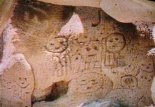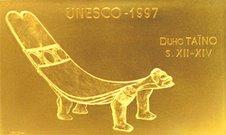A group of Caribbean indigenous nations gathered for special ceremonies and events in late May during the 4th United Nations Permanent Forum on Indigenous Issues, held in New York City. The indigenous movement in the Caribbean represents one of the lesser-known currents of Native cultural and political resurgence. This spring at the United Nations, the various delegations of Caribbean indigenous peoples coalesced in interesting and welcome ways.
For the first time in many years, Caribbean indigenous representatives were able to meet, share food and culture, and get down to the hard work of U.N. resolutions, interventions and document reaffirmation that marks much of international work. The Taino Nation of the Antilles, with primary bases in Puerto Rico and New York City, organized events for Caribbean delegates. It fund-raised the costs of one delegate from Dominica and coordinated presentations. Roberto Borrero, a Taino who serves on the NGO committee of the Indigenous Permanent Forum, also helped fund delegates to the event and has been active in hemispheric organizing. An Indigenous Peoples Caucus of the Greater Caribbean has been formed.
Carib cultural activist Prosper Paris, among others, joined the U.N. events. Prosper is from the Carib Territory in the north coast of the small Caribbean island of Dominica. He was one of several presenters on a panel on Indigenous Education and Cultural Survival organized by the Taino Nation. This writer chaired the panel, held at the customary indigenous gathering place in New York City: the United Nations Church Center at 777 United Nations Plaza, where several dozen Taino, Carib, Arawak, Guajiro and other indigenous peoples gathered.
The notable event, ably organized by Vanessa Pastrana, Inarunikia, among other volunteers from the Taino Nation, featured a dance presentation from young Taino people and recitations in the Taino language that are the product of a vigorous reconstruction and relearning of the insular Arawak language by members of that nation since the 1980s.
"From Cuba, in the mountains of the Sierra, from Dominican Republic, from our own Boriken [Puerto Rico], we have met relatives, holding on to our identity and retaking our indigenous roots,'' said Cacique Cibanakan, of the Taino Nation. ''Our hearts pound with excitement that our people are coming together."
Indigenous delegates from all over the world arrive in New York City every spring for the now-permanent U.N. forum on Indigenous peoples' issues. There are always dozens if not hundreds of important and fascinating stories - both positive and negative - on the conditions of tribal peoples and on the always tortuous and troubled trajectory in the world of highly exploitative industries, with their rapacious hunger for indigenous lands and natural resources.
In too many cases, the political contentions of land and resources are accompanied by attacks on Native leaders and political and social structures. Quechua and Aymara from Bolivia and Ecuador, Kuna from Panama, Maya from Guatemala, northern Canadian Cree leaders, Lakota treaty chiefs and Haudenosaunee traditionalists from the United States and Saami from Norway, among many others, sustained a necessary dialogue on human rights and development through the work of U.N. gatherings.
In New York representing the Arawak community at Joboshirima in Venezuela, Chief Reginaldo Fredericks found a not-so-distant relative in Daniel Rivera, Wakonax, one of the active leaders in the Taino movement in Puerto Rico and the diaspora. The Arawak chief, who is Onishido Clan and lives mostly in the rain forest, was very happy to meet Taino relatives.
Among the messages carried by Fredericks from his people is the need to preserve and restore indigenous language. He commended the Taino language recovery program, developed by the nation's elder language advocate, Jose Laboy, Boriquex, and offered to help bring together the Arawak (Lokono) peoples wherever possible. ''It is wonderful we are more and more recognizing each other; we have a lot to offer each other,'' Rivera, who made an intervention at the United Nations on behalf of Caribbean Indian peoples, responded.
Of the many currents of indigenous movement across the Western Hemisphere, the Caribbean is the most hidden and marginalized. As communities, clans and nations coalesce, however, encounters such as the one at the United Nations in New York, provide common ground for exchange and mutual education. The shared cultural history is fascinating.Fredericks narrated stories of his people to the Taino Nation elder, which tell of six original Lokono (later Arawak) nations, which the chief called ''clans.'' Of the six ''clans,'' three are unaccounted for while Taino is in the process of vigorous cultural and social recovery.
According to Fredericks, the ancient Lokono tribes or clans were called Oralido, Cariafudo, Onishido ''rain people,'' Gimragi, Way'u, and the ''good people'' from the great islands (Taino). Today, ''as far as we know,'' the chief reported, only Onishido and Way'u survive on the mainland. The chief was most intrigued that hundreds and perhaps thousands of Taino descendants from the islands of the Greater Antilles are reaffirming themselves. The chief pointed to his headdress, which shows six feathers, symbolizing the six tribes or clans of the Lokono. ''The good island people, the Taino, are one of the six feathers,'' Fredericks reminded the other Caribbean delegates.
From La Guajira, Colombia, Karmen Ramirez represented the Way'u Morerat ORJUWAT organization. She pointed out not only her Native Way'u nation, but also four tribes from Sierra Nevada de Santa Marta as Arawaks who originate with the Way'u of the Guajira Peninsula. It was another instance of people from common ancestors and linked contemporary identities meeting and recognizing each other as a result of an indigenous international movement. The Way'u, who also reside in neighboring Venezuela, are one of those peoples hurtfully divided by an international border.
Caribbean indigenous delegates, in the shadows for decades if not centuries, put their statements into the record at the annual U.N. event. The Caribbean indigenous caucus signaled the following major goal: ''That the collective rights of the indigenous peoples of the Greater Caribbean to lands, territories, resources, and traditional knowledge be enshrined in the Constitution of all Greater Caribbean countries and in other states where indigenous peoples exist.''
Author: Jose Barreiro
Source: Indian Country Today
Author: Jose Barreiro
Source: Indian Country Today











